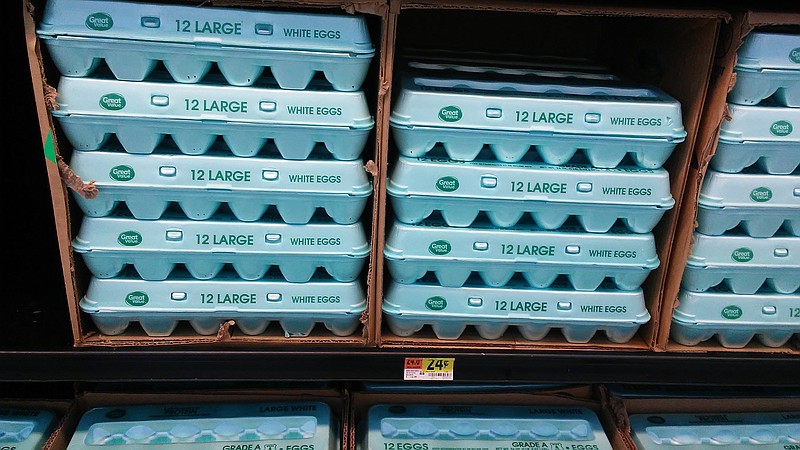Egg Prices
Wholesale prices for a dozen white, large Midwestern eggs during the first week of July:› 2012: $1.09› 2013: $1.23› 2014: $1.36› 2015: $2.01› 2016: $0.98› 2017: $0.83Source: Urner Barry, a New Jersey-based commodity market research company
It only costs 24 cents to buy a dozen store-brand eggs this week at Walmart Supercenter on Highway 153 in Hixson.
That's one example of eggs being the cheapest they've been in years, which is great for omelet-loving shoppers - but not so much for egg producers.
"They're not worth the wear and tear on the hens' butts right now," said Ray Hilburn, associate director of the Alabama Poultry and Egg Association.
A number of factors have combined to deflate the price of what the industry calls "table eggs" or "shell eggs" that mostly come from the Midwest, since it's home to much of the corn and soy used to feed hens.
Bird flu played a big role in lower table egg prices- in a roundabout way.
Egg prices already were on the rise when, for two months starting in mid-April 2015, the H5N2 virus ravaged chicken farms in Iowa - the leading table egg producer - and wiped out 12 percent of the country's egg-laying hens. By May 2015, egg production had fallen 28 percent from the previous year.
In response to low supply and high prices, farmers increased their number of hens. But that resulted in a glut of table eggs on the market.
"It didn't take long to flood the market," Hilburn said. "There's just too much supply for the demand."
Exports, baked-good industry demand both down
Bird flu also reduced demand by the baked-good industry, because - faced with soaring egg prices and outright egg shortages - commercial bakeries figured out how to do without eggs in their products or use egg replacements or extenders, such as soy and whey, said Brian Moscogiuri a shell egg and egg products analyst for the New Jersey-based commodity market research company Urner Barry.
The average wholesale price for a dozen, large white Midwestern eggs was $2.01 on the first week of July 2015 compared to just 83 cents a dozen now.
"We've gone from record highs to record lows in just a couple years," Moscogiuri said.
Also, egg demand normally goes down this time of year, he said, since people don't eat as much, overall, in the summer and they cut back on hot breakfasts and baking at home.
Some big stores that sell groceries use staples, such as eggs, milk and toilet paper as "loss leaders," or items sold at a loss to lure customers into their stores, Moscogiuri said.
Asked if the 24-cent eggs in Hixson were a loss leader, a Walmart spokesman declined to say.
"For competitive reasons, we won't be able to get into those details," said Charles Crowson, Wal-Mart senior manager of corporate communications via email. "We continuously look for ways to drive down costs and deliver savings to our customers. That's why we're giving customers in select markets even lower prices on the national and private-label brands."
Walmart isn't the only big box store in Chattanooga to sell eggs for 24 cents a dozen, which is 16 cents per pound.
"My co-worker goes to Aldi's and she can buy eggs for 24 cents a dozen," said Tom Stebbins, the UT Extension Agent for Hamilton County. "Gosh, 24 cents. I think that's not good for the farmer."
The Associated Press contributed to this report.
Contact staff writer Tim Omarzu at tomarzu @timesfreepress.com or www.facebook.com/MeetsForBusiness or on Twitter @meetfor business or 423-757-6651.
